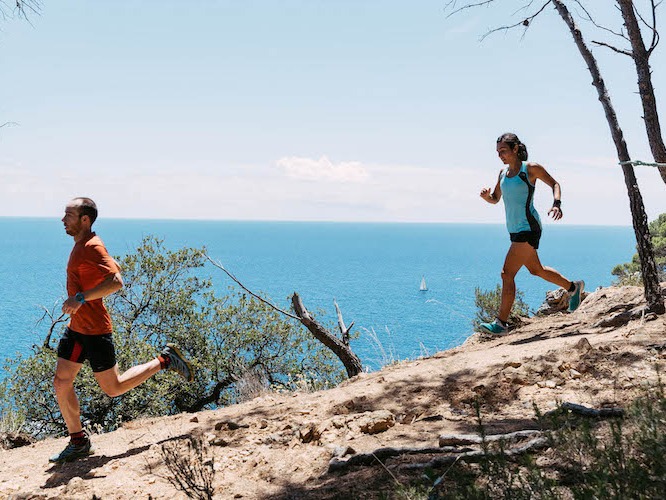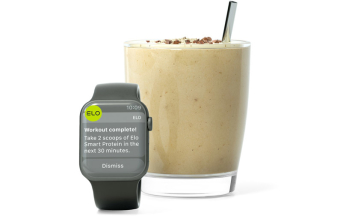Does intense exercise increase longevity?
Intense exercise, such as swimming, running, and jumping rope, can help increase longevity and reduce your risk of disease, however, you can have too much of a good thing. Learn more about the long-term health benefits of these activities, as well as how to track heart rate zones to boost performance levels and longevity.

If you’re looking for ways to increase your lifespan, incorporating intense exercise into a workout routine is something to consider. Vigorous exercise can help improve a range of essential biomarkers, including resting heart rate, blood pressure, body composition, blood flow to muscles, and muscle strength, all of which are important indicators of health and disease.
Before we dive into the relationship between exercise intensity and longevity, let’s first examine what counts as high-intensity exercise.
What counts as vigorous exercise?
Measuring your heart rate before, during, and after your workout is one of the most effective ways to gauge exercise intensity. By tracking your heart rate, you can determine how much effort you’re putting into each workout, as well as what these numbers mean for overall heart health.
Track your heart rate
There are three different ranges of exercise intensity—low, moderate, and intense—and each one has a different set of heart rate zones attached to them. Low- and moderate-intensity exercises are completed with less physical strain, while vigorous exercise is a form of activity that is done with a large amount of effort which results in reaching 70 to 85 percent of your maximum heart rate [1].
To calculate your maximum heart rate, subtract your age from 220, and this will result in the average maximum number of times your heart should beat per minute during exercise.

Examples of vigorous activity
Generally speaking, high-intensity exercise can be any activity that requires 7/10 effort or higher and is difficult to sustain. You should be short of breath but may still be able to speak in choppy sentences. Examples of vigorous activity include swimming, playing soccer, jumping rope, or running over 5 MPH.
Correlation between exercise and longevity
Increase the intensity to prolong your life
Regular exercise is one of the most beneficial things you can do for your body (other than paying attention to nutrition, of course!). From improved mental health to better sleeping patterns to weight management, there are so many ways that exercise benefits the body. But what about increasing your lifespan?
A recent study showed that women with poor exercise capacity (less than 10 METs) had an annual rate of death from cardiovascular disease of four times greater than women with good exercise capacity of 10 METs or more [2].
Another study showed people who had a higher ratio of vigorous to moderate activity ratio (at least 150 minutes of intense exercise per week) had a lower risk of all-cause mortality, which is commonly used to gauge lifespan [3].
Why does intense exercise reign supreme?
Vigorous activity improves VO2peak, resting heart rate, blood pressure, blood flow to muscles, and muscle strength, all of which are important biomarkers for overall health [4, 5, 6]. These biomarkers have a strong correlation with cardiovascular disease, type 2 diabetes, insulin sensitivity, and even death - and improving these numbers can be helpful for extending your life and healthy years. [7]. Intense exercise also helps with weight management and improves body composition, such as increasing lean muscle mass and boosting metabolism for several hours post-workout.

Athlete’s heart: a natural adaptation
Participating in intense exercise for more than five hours per week may result in a phenomenon deemed “athlete’s heart”. Essentially, vigorous activity causes the heart to remodel over time. The chamber size of the left ventricle, and the muscle mass and wall thickness of the heart increase to pump more blood through the body and meet the oxygen demands of working muscles [8, 11]. When the size of the left ventricle increases, heart rate decreases while still maintaining the right amount of cardiac output. As the heart continually endures this type of physical stress, it may lead to remodeling of the heart or thicker heart walls [8]. It’s important to keep in mind that this is a natural occurrence and can happen as the heart adapts to intense athletic training.
An athlete’s heart only becomes an issue if you have a pre-existing heart condition, so consult your doctor before starting (or continuing) to increase your training levels.
Can you do too much intense exercise?
The more you exercise, the better, right? Not necessarily true! There is such a thing as overdoing it, and by pushing yourself too hard, you risk injury, negating your results, reaching burnout, or damaging your heart [9].
In fact, large exercise volumes and vigorous-intensity exercises have both been associated with accelerated coronary artery calcification, myocardial fibrosis, and other potential cardiac maladaptations [9,10]. For those with an underlying cardiac disease, high-intensity exercise can increase the risk of heart rhythm disorders, atrial fibrillation, cardiac arrest, or sudden cardiac death [10,11].
Consult your healthcare provider about identifying any underlying cardiac issues! This will help you understand your physical limits and how best to tailor your training sessions to achieve maximum performance.
To avoid over-training and to achieve maximum cardiovascular results, consider doing moderate-intensity cardio with some vigorous activity sprinkled in a few days per week. This will help to supplement your workouts and take your intensity to the next level without overdoing it. Plus, it will keep things new and exciting. If you find that you’re extra sore and tired after a workout or series of workouts, listen to your body. Sometimes extra rest is exactly what your body needs.

Tips for athletes
If you want to incorporate more vigorous exercises into your routine, here are some ways to (safely) spice things up and get your heart rate pumping:
Introduce interval training. Add in some high-intensity exercises to training sessions a few times per week for additional heart health benefits. This will help improve overall performance as well as longevity.
Find your target heart rate zone. Take your training to the next level by finding your maximum heart rate and catering your activity levels to those zones. Be cautious to not exceed your maximum heart rate and be sure to pay attention to how you feel during any workout.
Recover properly. High-intensity training sessions can be exhausting, so don’t skip the recovery phase! Be sure to drink enough water, eat a nutritious post-workout snack, cool down properly, and take it easy on rest days to avoid injury.
Summary
There is no denying the health benefits of physical activity, especially when it comes to high intensity workouts. Incorporating vigorous exercises into your routine can improve your longevity by reducing the risk of CVD, and improving blood pressure, insulin sensitivity, muscle mass, and body composition. Moreover, incorporating high intensity activity throughout the week can help you take your fitness and athletic performance to the next level.
As you continue to work in high intensity exercises into your routine, don’t forget about the importance of adequate recovery, as well as to watch for signs of overtraining, excess fatigue, or changes in your physical or mental health. By listening to your body, you will be able to gauge what it needs the most, which can help prevent injury, improve happiness, and increase lifespan.
Disclaimer: The text, images, videos, and other media on this page are provided for informational purposes only and are not intended to treat, diagnose or replace personalized medical care.
Key takeaways
Tracking your heart rate is an important indicator for physical activity levels and will help you understand how to train so you can take your workouts to the next level.
When you add in vigorous activity a few times a week to an overall moderate-level exercise routine, studies suggest that you can experience overall health benefits and improve your fitness levels [5].
Add in high intensity activity between lighter sessions to reap the benefits of vigorous exercise without overdoing it. [12].
When high intensity exercise is done consistently and correctly your body will learn to adapt to the higher level of stress, which proves to be beneficial in the long term.
References
AHA Editorial Staff. (2021, March 9). Target Heart Rates Chart. American Heart Association. https://www.heart.org/en/healthy-living/fitness/fitness-basics/target-heart-rates.
European Society of Cardiology. (2019, December 7). Women, exercise and longevity. ScienceDaily. https://www.sciencedaily.com/releases/2019/12/191207073534.htm#:~:text=The%20annual%20rate%20of%20death,(2.2%25%20versus%200.6%25).
Wang, Y., Nie, J., Ferrari, G., Rey-Lopez, J. P., & Rezende, L. F. (2021). Association of Physical Activity Intensity With Mortality. JAMA Internal Medicine, 181(2), 203–211. https://doi.org/10.1001/jamainternmed.2020.6331
Batacan, R. B., Duncan, M. J., Dalbo, V. J., Tucker, P. S., & Fenning, A. S. (2016). Effects of high-intensity interval training on cardiometabolic health: a systematic review and meta-analysis of intervention studies. British Journal of Sports Medicine, 51(6), 494–503. https://doi.org/10.1136/bjsports-2015-095841
Gabbett, T. (2017). Infographic: The training–injury prevention paradox: should athletes be training smarter and harder? British Journal of Sports Medicine, 52(3), 203–203. https://doi.org/10.1136/bjsports-2016-097249
Shawn Radcliffe. (2019, December 6). Vigorous Exercise Can Greatly Reduce Your Risk of Cancer, Heart Disease. Healthline. https://www.healthline.com/health-news/women-urged-to-exercise-vigorously-to-stay-heart-healthy.
Gibala, M. J., & Little, J. P. (2019). Physiological basis of brief vigorous exercise to improve health. The Journal of Physiology, 598(1), 61–69. https://doi.org/10.1113/jp276849
Azevedo, P. S., Polegato, B. F., Minicucci, M. F., Paiva, S. A., & Zornoff, L. A. (2016). Cardiac Remodeling: Concepts, Clinical Impact, Pathophysiological Mechanisms and Pharmacologic Treatment. Arquivos Brasileiros De Cardiologia, 106(1), 62–69. https://doi.org/10.5935/abc.20160005
Franklin, B. A., Thompson, P. D., Al-Zaiti, S. S., Albert, C. M., Hivert, M.-F., Levine, B. D., Lobelo, F., Madan, K., Sharrief, A. Z., & Eijsvogels, T. M. H. (2020). Exercise-Related Acute Cardiovascular Events and Potential Deleterious Adaptations Following Long-Term Exercise Training: Placing the Risks Into Perspective–An Update: A Scientific Statement From the American Heart Association. Circulation, 141(13), 705–736. https://doi.org/10.1161/cir.0000000000000749
Ellis, M. (2014, May 15). Is too much high-intensity exercise bad for your heart? Medical News Today. https://www.medicalnewstoday.com/articles/276784.
Athlete's Heart. Stanford Health Care (SHC) - Stanford Medical Center. (2017, September 11). https://stanfordhealthcare.org/medical-conditions/blood-heart-circulation/athletes-heart.html.
O’Keefe, J. H., Franklin, B., & Lavie, C. J. (2014). Exercising for Health and Longevity vs Peak Performance: Different Regimens for Different Goals. Mayo Clinic Proceedings, 89(9), 1171–1175. https://doi.org/10.1016/j.mayocp.2014.07.007







